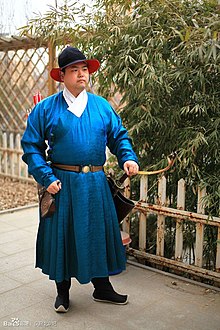Yesa robe
| Yesa robe | |||||||
|---|---|---|---|---|---|---|---|
 A modern yesa robe. | |||||||
| Chinese | 曳撒袍 | ||||||
| |||||||
| Alternative Chinese name | |||||||
| Chinese | 一撒 | ||||||
| |||||||
Yesa robe (Chinese: 曳撒袍; pinyin: Yèsāpáo), also known simply referred as Yesa (Chinese: 曳撒), Yisan (Chinese: 曳撒), or Yisa (Chinese: 一撒), is an ancient type of Chinese clothing worn during the Ming dynasty.[1][2] It originated in the Ming dynasty but was influenced from clothing of the Yuan dynasty.[1] It is sometimes described as being a sinicized version of the Mongol's jisün[3] and could only be found in China.[4] Yesa was a regular clothing in the Ming dynasty;[3] it was initially worn in the palace and by the wealthy, and it later spread to the commoners.[1]
Construction and design
The yesa robe is a cross-collared, long sleeved robe with narrow pleats on the lower hem; while the back of the lower part is flat, the front had two densely pleated sides with a flat middle,[1][4] similar to the mamianqun. It has two hems at each sides.[1][4] Compared to the Mongol Yuan's terlig, the sleeves and the bodice were wider; the pleats were also wide compared to very finely gathered skirt of the Mongol's terlig; the yesa also had no waistband; the skirt was also longer.[4]
The absence of the threaded/braided waistband, the absence of pleats at the centre back and front of the skirt; the presence of large side pleats were the main features of the yesa; these features were developed in the Ming dynasty and were not of Mongol origins. These features also differentiated it from its precursor.[4]
The yesa also showed sedentary life-style and Chinese cultural characteristics: its increase in length made it lose its functionality for horse-riding purposes, the flat centre back appeared as well-arranged pleats were to hard to maintain when sitting.[4] Moreover, the folds which were originally found at the centre front of the terlig also had to disappear as it interrupted the dignity of the vertical line,[4] a feature which was important in Chinese clothing culture.
History
Origins
During the Ming dynasty, some clothing incorporated the clothing elements from the Han Chinese and the Mongol clothing tradition; one of those mixed-elements is the yesa.[5] The clothing known as yesa originated in the Ming dynasty, but some of its elements were either adopted from the Yuan dynasty Mongol's terlig,[1] or directly from the Mongol's jisün clothing which is also a form of terlig.[5] The yesa is itself a new evolution of terlig.[4]
Ming dynasty
The yesa robe is a form of kuzhe (Chinese: 袴褶; clothing with trousers for riding or military style clothing); however, the design of the yesa made it no more functional for horse riding.[4][6]
The yesa was worn as an informal attire by emperors, princes, ministers, and officials in their spare time during the early period of the Ming dynasty; it was worn as a formal uniforms in some occasions during the middle period of the Ming dynasty; it was worn as a casual dress worn by scholar-officials during the mid-to-late period of the Ming dynasty; and eventually it was worn by servants and commoners in the late Ming.[1]
The Ming court eunuchs wore yesa robe in different styles, such as the red-coloured yesa robes with a qilin patch, round-collared yesa robes, and light green yesa robe, etc.[1]
Gallery
-
Jinyiwei Ming Dynasty.
Similar items
See also
References
- ^ a b c d e f g h Wei, Luo (2018-01-02). "A Preliminary Study of Mongol Costumes in the Ming Dynasty". Social Sciences in China. 39 (1): 165–185. doi:10.1080/02529203.2018.1414417. ISSN 0252-9203. S2CID 149138176.
- ^ "Ancient Chinese Robes for Men: Tieli & Yisan - 2020". www.newhanfu.com. 2020. Retrieved 2021-05-05.
- ^ a b Wang, Chen (2014-09-01). "Conservation study of Ming dynasty silk costumes excavated in Jiangsu region, China". Studies in Conservation. 59 (sup1): S177–S180. doi:10.1179/204705814X13975704319154. ISSN 0039-3630. S2CID 191384101.
- ^ a b c d e f g h i Cho, Woohyun; Yi, Jaeyoon; Kim, Jinyoung (2015). "The dress of the Mongol Empire: Genealogy and diaspora of theTerlig". Acta Orientalia Academiae Scientiarum Hungaricae. 68 (3): 22–29. doi:10.1556/062.2015.68.3.2. ISSN 0001-6446.
- ^ a b Wang, Guojun (2020). Staging personhood : costuming in early Qing drama. New York. ISBN 978-0-231-54957-8. OCLC 1129398697.
{{cite book}}: CS1 maint: location missing publisher (link) - ^ Finnane, Antonia (2008). Changing clothes in China : fashion, history, nation. New York: Columbia University Press. p. 45. ISBN 978-0-231-14350-9. OCLC 84903948.




